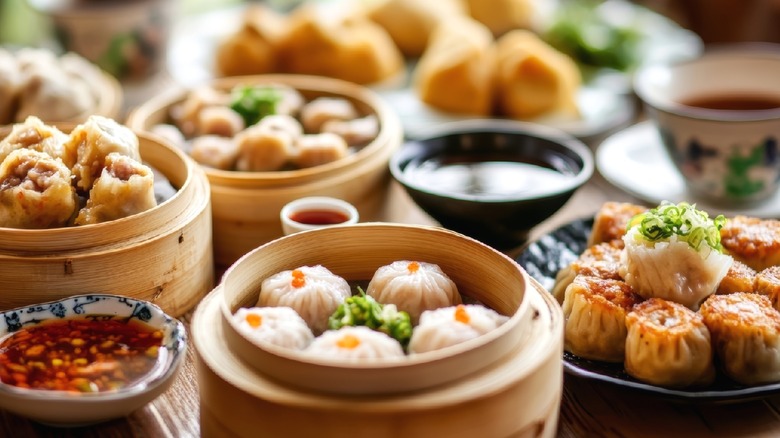The Correct Number Of Dim Sum Dishes To Order Per Person
If you've never lived near a city with a major Chinese population, you may not have had the chance to experience dim sum. It's kind of like a more formalized (if not necessarily more formal) version of tapas: carts containing loads of snacks and appetizers are pushed around a large dining room, where patrons can choose what dishes they might like. (You may also get a menu with a pencil you can use to mark your choices.) And with such a dizzying array of choices — often including, but by no means limited to, scallion pancakes, soup dumplings, shrimp toast (which you can make at home), and egg tarts — it's hard to know when to stop yourself. So, how many dim sum plates can one person order? It depends on who you ask, with the general consensus being between two to four dishes per person.
There are a few important things to keep in mind here. For one thing, you know your own appetite (and the appetites of the people you go with) better than anyone else. For another thing, dim sum dishes are usually designed to be shared, meaning that it's entirely possible you and the rest of your party will enjoy little bites of everything regardless of who orders what. You can make your own decisions about how much you're able to eat. But it's important to be considerate of everyone else in the dining room — some of the most popular dishes can sell out before the cart even reaches the end of the dining hall, so don't hog it all to yourself.
Keep in mind what's really important about dim sum
It's easy to get caught up worrying about the exact number of dishes per person. Some people suggest you only get two per person, while others say you can go up to five. You certainly don't want to step on anybody's toes, so what exactly should you do? Well, first of all, don't worry about it too much. As long as you're not eating a truly extravagant amount, you should be fine. It's important to remember what's really important about dim sum, which is about more than just food. (Like Hello Kitty, which got its own themed dim sum restaurant back in 2015.)
In fact, dim sum is often called "yum cha," which literally means "to drink tea." Whatever it's called, tea is non-optional and a significant part of the experience. The tea is served as soon as you sit down (usually jasmine or oolong), and you're expected to pour for others before you pour for yourself. It's another reminder that the most important part of dim sum is its communal spirit. Need more proof? The phrase "dim sum," in Cantonese, means "to touch the heart." We're happy to munch on a taro croquette in honor of that sentiment.

